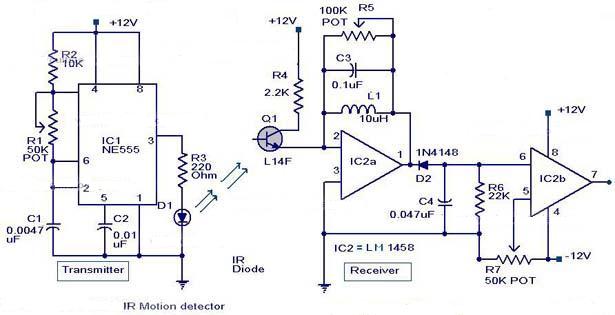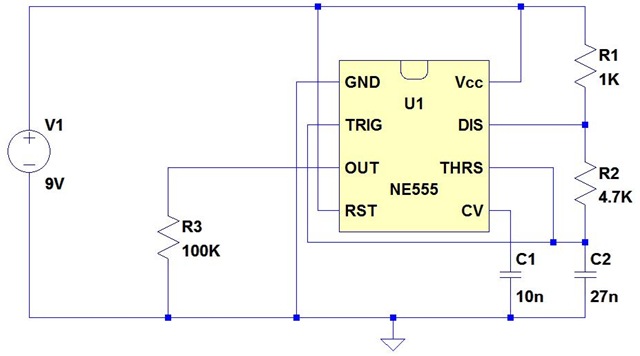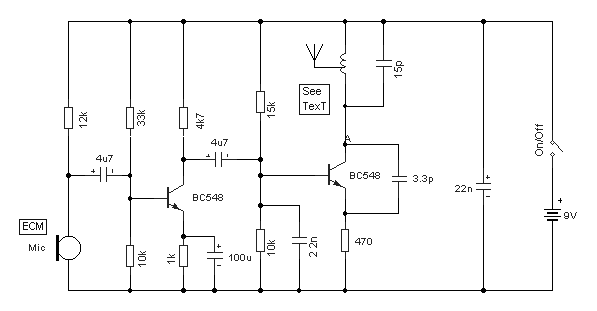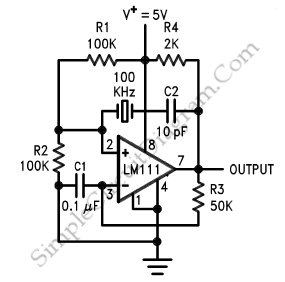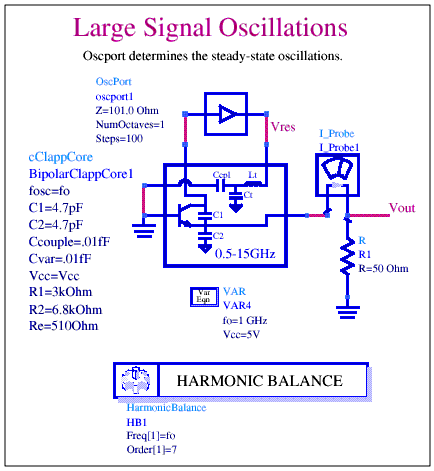
RC audio oscillator with 555
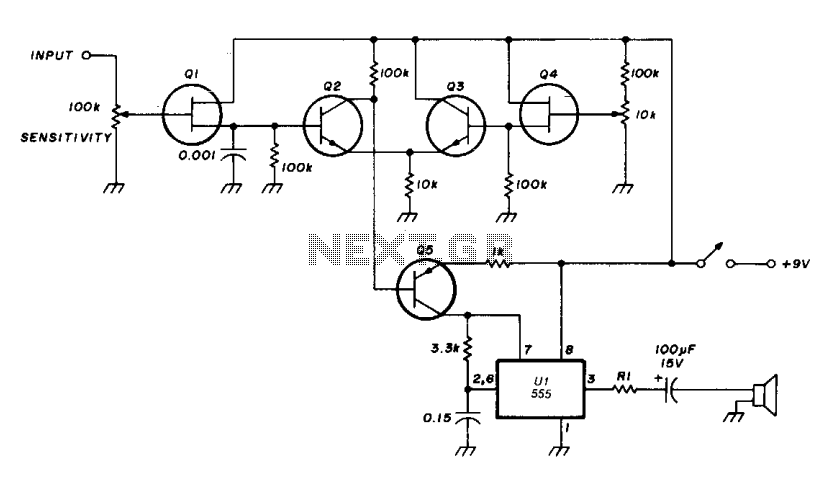
The transistor Q5 and the 1000-ohm resistor form the variable element necessary for controlling the frequency of the voltage-controlled oscillator (VCO) by limiting the charging current flowing into the 0.15 microfarad timing capacitor based on the forward bias applied to Q5. When the voltage at pins 2 and 6 of U1 reaches 2A Vcc (approximately 6 volts with a 9-volt supply), the timer activates, causing pin 3 to be pulled low. Pin 7, which is an open collector output, also goes low, initiating the discharge of the timing capacitor through the 3.3-kilohm resistor. The discharge time provided by this resistor ensures a reasonable, albeit asymmetrical, waveform for the aural signal generated by U1. At 1A Vcc, the internal flip-flop resets, causing the output at pin 3 to go high, the open collector output on pin 7 to float, and the timing cycle to commence anew.
The circuit primarily involves a voltage-controlled oscillator (VCO) that utilizes a transistor (Q5) and a resistor (1000 ohms) for frequency modulation. The VCO operates by adjusting the charging current to a timing capacitor (0.15 µF), which directly influences the oscillation frequency. The forward bias applied to Q5 modulates this charging current, allowing for dynamic frequency control.
When the voltage at pins 2 and 6 of the timer IC (U1) reaches a threshold of 2A Vcc, which corresponds to approximately 6 volts in this configuration with a 9-volt power supply, the timer is triggered. This action results in pin 3 being pulled low, indicating the start of a timing cycle. Simultaneously, pin 7, configured as an open collector output, also transitions low, which initiates the discharge process of the timing capacitor through a 3.3-kilohm resistor.
The discharge time, governed by the 3.3-kilohm resistor, is crucial in shaping the output waveform of the VCO. This resistor ensures that the waveform, while asymmetrical, remains within acceptable limits for generating an aural signal. The waveform's characteristics are essential for applications that require specific frequency modulation, making this arrangement particularly useful in audio signal generation or similar applications.
Once the voltage drops to 1A Vcc, the internal flip-flop mechanism within the timer IC resets. This reset action causes pin 3 to return to a high state, while the open collector output on pin 7 becomes inactive (floats). This reset condition marks the end of the timing cycle, allowing the process to repeat, thus maintaining continuous oscillation and providing a stable output frequency for the desired application. The overall design emphasizes the importance of component selection and configuration in achieving precise control over signal generation in electronic circuits.Transistor Q5 and the 1000 ohm resistor form the variable element needed for controlling the frequency of VCO by limiting the charging current flowing into the 0.15 timing capacitor according to the forward bias being applied to Q5. As the voltage on pins 2 and 6 of Ul reach 2A Vcc (about 6 volts with a 9-volt supply) the timer will fire and pin 3 will be pulled low.
Pin 7, an open collector output, goes low and begins to discharge the timing capacitor—through the 3.3 kilohm resistor. The discharge time provided by this resistor assures a reasonable, although asymmetrical, waveform for the aural signal generated by Ul. At lA Vcc the internal flip-flop resets, the output on pin 3 goes high, the open collector output on pin 7 floats, and the timing cycle begins again.
🔗 External reference
The circuit primarily involves a voltage-controlled oscillator (VCO) that utilizes a transistor (Q5) and a resistor (1000 ohms) for frequency modulation. The VCO operates by adjusting the charging current to a timing capacitor (0.15 µF), which directly influences the oscillation frequency. The forward bias applied to Q5 modulates this charging current, allowing for dynamic frequency control.
When the voltage at pins 2 and 6 of the timer IC (U1) reaches a threshold of 2A Vcc, which corresponds to approximately 6 volts in this configuration with a 9-volt power supply, the timer is triggered. This action results in pin 3 being pulled low, indicating the start of a timing cycle. Simultaneously, pin 7, configured as an open collector output, also transitions low, which initiates the discharge process of the timing capacitor through a 3.3-kilohm resistor.
The discharge time, governed by the 3.3-kilohm resistor, is crucial in shaping the output waveform of the VCO. This resistor ensures that the waveform, while asymmetrical, remains within acceptable limits for generating an aural signal. The waveform's characteristics are essential for applications that require specific frequency modulation, making this arrangement particularly useful in audio signal generation or similar applications.
Once the voltage drops to 1A Vcc, the internal flip-flop mechanism within the timer IC resets. This reset action causes pin 3 to return to a high state, while the open collector output on pin 7 becomes inactive (floats). This reset condition marks the end of the timing cycle, allowing the process to repeat, thus maintaining continuous oscillation and providing a stable output frequency for the desired application. The overall design emphasizes the importance of component selection and configuration in achieving precise control over signal generation in electronic circuits.Transistor Q5 and the 1000 ohm resistor form the variable element needed for controlling the frequency of VCO by limiting the charging current flowing into the 0.15 timing capacitor according to the forward bias being applied to Q5. As the voltage on pins 2 and 6 of Ul reach 2A Vcc (about 6 volts with a 9-volt supply) the timer will fire and pin 3 will be pulled low.
Pin 7, an open collector output, goes low and begins to discharge the timing capacitor—through the 3.3 kilohm resistor. The discharge time provided by this resistor assures a reasonable, although asymmetrical, waveform for the aural signal generated by Ul. At lA Vcc the internal flip-flop resets, the output on pin 3 goes high, the open collector output on pin 7 floats, and the timing cycle begins again.
🔗 External reference
Warning: include(partials/cookie-banner.php): Failed to open stream: Permission denied in /var/www/html/nextgr/view-circuit.php on line 713
Warning: include(): Failed opening 'partials/cookie-banner.php' for inclusion (include_path='.:/usr/share/php') in /var/www/html/nextgr/view-circuit.php on line 713
